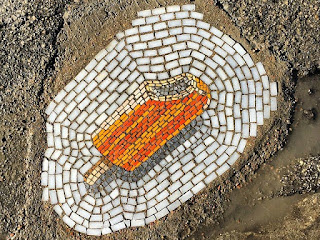Throughout the school year, you spend a majority of time in your classes discussing artists, cultures, concepts, and history, on top of creating projects inspired by those ideas. Having a variety of teaching strategies in the art class helps students of all learning styles develop their skills. One element you can include is using art games in your class.
Why include
games in art? Students enjoy a change of
pace, especially when their given small challenges to improve their creative
thinking skills. You can include games
and mini-challenges in quite a few different ways, such as time-fillers,
beginning activities for lesson units, or quick tests in the middle of
projects.
Challenge Capsules: My 7 year old daughter loves those
quarter machines that give you the capsule with a tiny toy inside. Over time, those little capsules end up all
over the house or in recycling. Now
imagine if you saved those plastic capsules for your art class? Similar to a fortune cookie, write out
artistic challenges to place in the empty capsules. When a student finishes early and doesn’t
know what they want to do to fill their time, have them choose a capsule
challenge to complete on their own! The
challenges could include drawing exercises, origami designs, or low-key collage
work. Keep your capsules in a large
Tupperware or jar for the students to choose from!
Hue Knew!: Hue Knew is a small game that
multiple students can play together. The
game has different circles with over 9 different color names (printed in
different colors), and 10 pegs total.
The game helps students to identify the color with the word while
helping them to think faster than their opponents. I’ve had the game in my classroom for years,
all the pieces are still there, and students love to team up and play when
multiple people are finished!
Tangoes:
Tangoes is an excellent art game that exercises critical thinking
skills. In the game container, you’re
given a few geometric shapes (triangles, squares, etc.) and cards with random
designs. The trick is to fill in the
designs with the shapes provided to the player.
It is amazing watching my students figuring out the puzzle to each
design given.
Art Dice-While floating around on the
Pinterest site, I found many bloggers who created their own “dice” exercise to
help build a drawing. My favorite one to
use is the worksheet with shapes seen in Joan Miro’s artworks. Students at their tables roll the dice, then
whatever number they get corresponds with the shape given in the
worksheet. In the end, you get a
Miro-Inspired creation that students can use for bigger projects! I’ve also seen this exercise used to build
monsters and Keith Haring-inspired drawings!
These worksheets can be designed by you, or you can find then in a
Google search as a classroom resource.
Exquisite corpse is a creative method of collecting words or images in an assembled
collaboration. Each person involved add to the sentence or artwork without
knowing what was previously written or drawn, then once passed around, you can
reveal the completed sentence or artwork.
The technique was invented by surrealists back in the early 1900’s, but
artists and students use the fun activity to see what imaginative designs they
develop.
Create your own Jeopardy Game-If you go to the website SuperTeacher Tools, you can create your own jeopardy style game to use within your
classroom! Whatever game you create, as
long as you save the link, you can re-use for any classes you have over
time. You enter in the categories and the
answers, while the students guess the question!
I used this tool for my 6th grade students at the end of the year
once they finished their art history units.
Each category was a time period and sub-categories were vocabulary they
had learned throughout the year.
Symbaloo is a website that helps create a
bookmark page of your most visited sites.
Unlike Pinterest, which bookmarks sites into categories, Symbaloo is
designed for you to see thumbnails of your bookmarked sites in one page. This page can then be added as a widget to
your website or blog. Since I have a
classroom website already created, I added my Symbaloo widget to my home
page. When students are finished with
projects and have access to computers, all they need to do is visit my website
and click and choose which sites and games they wish to play online!
Psst...would you like to see my symbaloo board for art games? Click on my link on top of his page, Art With Mrs. O'Hanley!
Psst...would you like to see my symbaloo board for art games? Click on my link on top of his page, Art With Mrs. O'Hanley!
There are so
many ways to include games and challenges in your art class, no matter if you’re
in a classroom or cart. It’s amazing to
see the faces of my students when I spring a game on them to exercise their imaginations!












